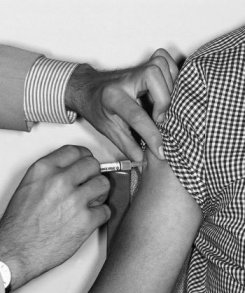 Researchers may have broken the impasse that has frustrated the invention of an effective HIV vaccine by bypassing the usual method of development. By using gene transfer technology that produces molecules that block infection, the scientists have protected monkeys from infection by a virus closely related to HIV - the simian immunodeficiency virus (SIV) - that causes AIDS in rhesus monkeys.
Researchers may have broken the impasse that has frustrated the invention of an effective HIV vaccine by bypassing the usual method of development. By using gene transfer technology that produces molecules that block infection, the scientists have protected monkeys from infection by a virus closely related to HIV - the simian immunodeficiency virus (SIV) - that causes AIDS in rhesus monkeys. "We used a leapfrog strategy, bypassing the natural immune system response that was the target of all previous HIV and SIV vaccine candidates," said study leader Philip R. Johnson, at The Children's Hospital of Philadelphia. Explaining his work in Nature Medicine, Johnson cautioned that many hurdles remain before the technique used in this animal study might be translated into an HIV vaccine for humans.
Most past attempts at developing an HIV vaccine have used substances aimed at stimulating the body's immune system to produce antibodies or killer cells that would eliminate the virus before or after it infected cells in the body. However, clinical trials have been disappointing. HIV vaccines have not elicited protective immune responses, just as the body fails on its own to produce an effective response against HIV during natural infection.
The approach taken in the current study was divided into two phases. In the first phase, the research team created antibody-like proteins (immunoadhesins) that were specifically designed to bind to SIV and block it from infecting cells. Once proven to work against SIV in the laboratory, DNA representing SIV-specific immunoadhesins was engineered into a carrier virus designed to deliver the DNA to monkeys. The researchers chose adeno-associated virus (AAV) as the carrier virus because it is a very effective way to insert DNA into the cells of a monkey or human.
In the second part of the study, the team injected AAV carriers into the muscles of monkeys, where the imported DNA produced immunoadhesins that entered the blood circulation. One month after administration of the AAV carriers, the immunized monkeys were injected with live, AIDS-causing SIV. The majority of the immunized monkeys were completely protected from SIV infection, and all were protected from AIDS. In contrast, a group of unimmunized monkeys were all infected by SIV, and two-thirds died of AIDS complications. Impressively, high concentrations of the SIV-specific immunoadhesins remained in the blood for over a year.
"To ultimately succeed, more and better molecules that work against HIV, including human monoclonal antibodies, will be needed," Johnson noted, adding that; "[the] approach may also have potential use in preventing other infectious diseases, such as malaria."
Related:
HIV boffins look to slow-progressors for antibody recipe
Gene therapy shows promise against HIV
Trial Of HIV Vaccine Starts In Africa
Worldwide Trial For HIV Vaccine
Source: Children's Hospital of Philadelphia





